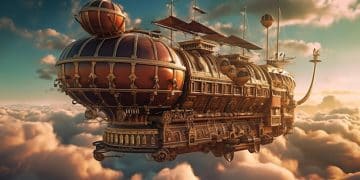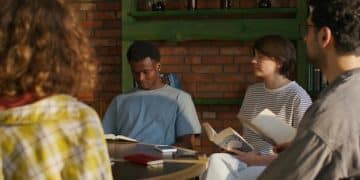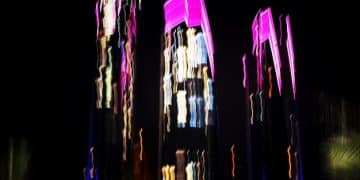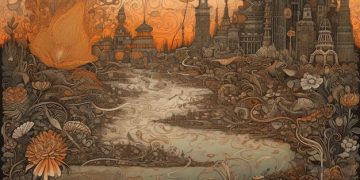Gothic Horror’s Enduring Appeal: Latest Trends in Novels
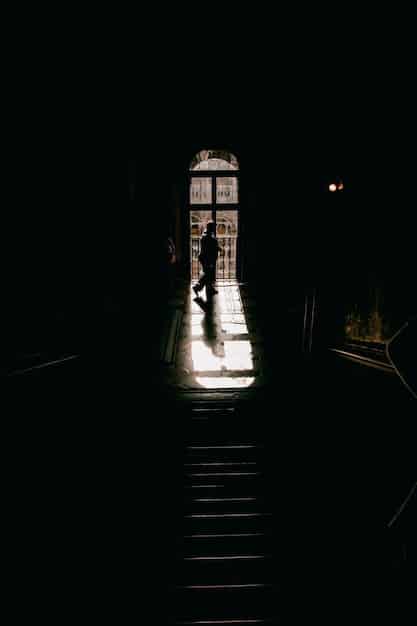
Gothic horror’s enduring appeal lies in its exploration of dark themes, psychological torment, and atmospheric settings, with recent trends in novels showcasing a resurgence of classic tropes alongside innovative approaches to storytelling.
The allure of gothic horror remains strong, captivating readers with its blend of suspense, mystery, and the supernatural. This article delves into gothic horror’s enduring appeal: analyzing the latest trends in gothic horror novels, exploring how authors are revitalizing classic elements while introducing fresh perspectives.
The Timeless Allure of Gothic Horror
Gothic horror, a genre steeped in atmosphere, mystery, and the supernatural, has maintained its grip on readers for centuries. Its ability to tap into primal fears and explore the darker aspects of human nature ensures its continued relevance.
From crumbling castles to tormented heroines, the classic tropes of gothic horror provide a rich foundation for contemporary authors to build upon, offering both comfort and chilling familiarity.
Key Elements of Classic Gothic Horror
Classic gothic horror is defined by certain recurring elements that create its distinctive atmosphere of dread and suspense. These elements, while often updated, remain foundational to the genre.
- Setting: Isolated and imposing locations like castles, mansions, and ancient ruins.
- Atmosphere: A pervasive sense of gloom, mystery, and foreboding.
- Characters: Often features tormented protagonists, damsels in distress, and Byronic heroes.
- Supernatural Elements: Ghosts, curses, and other unexplained phenomena that blur the line between reality and illusion.
The genre’s exploration of psychological states, such as madness, obsession, and repressed desires, also contributes to its lasting appeal. By delving into the inner turmoil of its characters, gothic horror reveals the darkness that can reside within us all.
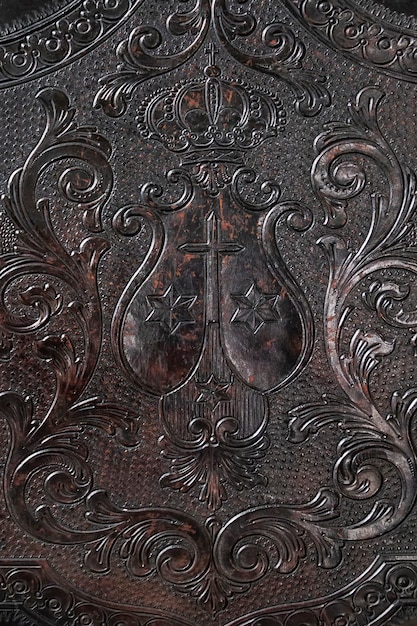
In essence, the timeless allure of gothic horror lies in its ability to create a world of shadows and secrets, where the past haunts the present and the line between the natural and supernatural becomes terrifyingly thin.
Modern Gothic: A Resurgence of the Dark
In recent years, there’s a definite resurgence of gothic horror in literature, with authors breathing new life into classic themes. This modern gothic often blends traditional elements with contemporary sensibilities, appealing to a new generation of readers.
These novels explore familiar gothic tropes, but with a modern lens, addressing contemporary issues and featuring diverse characters.
What Defines Modern Gothic Horror?
Modern gothic horror retains the core elements of its predecessors while incorporating new themes and perspectives. It often challenges traditional notions of gender, race, and identity, making the genre more inclusive and relevant.
- Social Commentary: Addressing contemporary issues such as social inequality, environmental concerns, and technological anxieties.
- Diverse Characters: Featuring protagonists from marginalized communities, offering new perspectives on gothic themes.
- Psychological Depth: Exploring the psychological impact of trauma, abuse, and societal pressures.
- Genre Blending: Combining gothic horror with elements of fantasy, science fiction, and thriller.
This revitalization ensures that gothic horror remains a vibrant and evolving genre, capable of reflecting the complexities of the modern world.
Modern gothic blurs these lines even further creating works that are both deeply unsettling and powerfully relevant.
Trends in Setting: From Castle to City
While classic gothic horror often relies on isolated castles and crumbling mansions, modern gothic has expanded its settings to include urban landscapes and contemporary environments.
This shift allows authors to explore the gothic themes of decay, isolation, and the supernatural in a new and unexpected ways.
Urban Gothic: Haunting the Metropolis
Urban gothic subverts expectations by placing gothic elements within bustling cities. This creates a unique juxtaposition between the modern and the ancient, highlighting the hidden darkness that can lurk beneath the surface of urban life.
The city itself becomes a character, with its labyrinthine streets, neglected buildings, and anonymous crowds serving as a backdrop for tales of alienation and dread.
- Decaying Infrastructure: Using abandoned buildings, subways, and industrial sites to create a sense of urban decay.
- Social Isolation: Exploring the loneliness and alienation that can exist in densely populated areas.
- Hidden Histories: Uncovering the dark secrets and forgotten pasts that haunt the city.
This trend reflects a growing interest in exploring the gothic within our own backyards, finding the eerie and unsettling in the everyday.
The use of urban environments serves as a reminder that the gothic is not confined to remote locations but can thrive anywhere where darkness and mystery intersect.
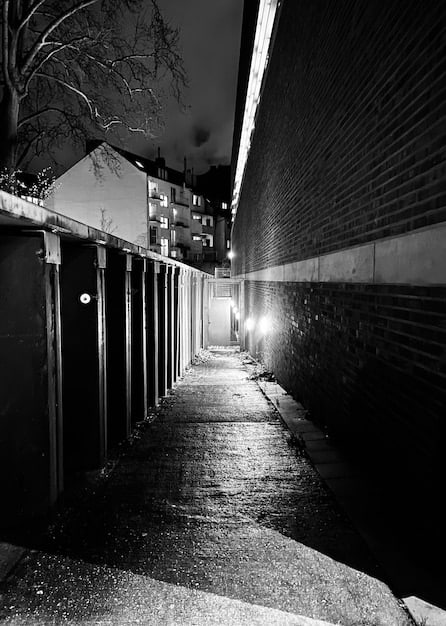
Exploring Psychological Depths: The Inner Demons
Psychological horror has always been a cornerstone of the gothic genre, but modern novels are delving deeper into the minds of their characters, exploring the complexities of trauma, mental illness, and repressed desires.
This focus on internal struggles adds a layer of realism and relatability to the gothic tradition, making the horror more visceral and impactful.
The Impact of Trauma and Mental Illness
Modern gothic novels often address the long-term effects of trauma and mental illness, portraying characters grappling with anxiety, depression, and PTSD. This exploration can shed light on the ways in which past experiences can haunt and shape the present.
By portraying characters struggling with mental health issues, these novels can destigmatize mental illness and create more empathetic and nuanced portrayals of the human condition.
The use of unreliable narrators adds another layer of psychological complexity to gothic narratives, blurring the line between reality and perception.
In this way, modern Gothic narratives are increasingly concerned with illustrating how the past shapes the present – and how it can actively influence an individual’s perception.
Gothic and Technology: A New Frontier
The intersection of gothic horror and technology is a relatively new but rapidly growing trend. This subgenre explores the ways in which technology can amplify our fears, create new forms of isolation, and blur the line between the human and the machine.
From haunted virtual realities to AI gone awry, these stories tap into our anxieties about the rapidly changing technological landscape.
This creates a new level of unease, reflecting our anxieties about the potential consequences of unchecked technological advancement.
Technological Terrors in the Digital Age
Gothic and technology often explore the dark side of the digital world, examining the potential for technology to be used for manipulation, surveillance, and control.
Stories involve:
- AI Golems: Exploring the the potential for AI to develop its own consciousness and turn against its creators.
- Virtual Realities: Featuring characters trapped in virtual worlds that become nightmares.
- Social Media: Examining the ways in which social media can be used to spread misinformation, incite hatred, and erode our sense of self.
By combining the classic tropes of gothic horror with contemporary technological anxieties, it creates narratives that are both unsettling and thought-provoking.
The blending of gothic horror and technology serves as a cautionary tale about the potential dangers of technological hubris, reminding us that progress is not always synonymous with advancement.
Blending Genres: Gothic Horror’s Evolution
One of the defining characteristics of modern gothic horror is its willingness to blend with other genres, pushing the boundaries of what is traditionally considered gothic.
This mixing of genres allows authors to explore gothic themes in new and innovative ways, appealing to a wider audience.
Hybridizing Gothic: Fantasy, Sci-Fi, and More
Gothic can be seen in different genres.
Examples include:
- Gothic Fantasy: Blending gothic elements with magical worlds and epic quests.
- Gothic Science Fiction: Exploring fears of technology, bioengineering, and the unknown in space.
- Gothic Thriller: Combining the dark atmosphere of gothic with suspenseful plots and psychological twists.
This genre blending is not just a stylistic choice but a way to expand the thematic possibilities of gothic horror, addressing contemporary issues through a variety of lenses.
The hybridization demonstrates the enduring adaptability of this genre.
| Key Point | Brief Description |
|---|---|
| 🏰 Classic Elements | Foundational elements like castles, atmosphere, and tormented characters. |
| 🌃 Urban Settings | Modern gothic expands to urban landscapes, creating new unease. |
| 🧠 Psychological Depth | Deeper exploration of trauma, mental illness, and inner demons. |
| 🤖 Technology Intrusion | Gothic horror integrates technology-related fear. |
Frequently Asked Questions
▼
Classic gothic horror includes settings like castles, a gloomy atmosphere, damsels in distress, and supernatural elements. These create the genre’s distinctive suspenseful mood and are foundational.
▼
Modern gothic retains core elements but incorporates contemporary issues like social inequality, diverse characters, psychological depth, and genre blending. It broadens the gothic narrative.
▼
Urban gothic places gothic elements in cities, creating unease and exploring themes of decay, isolation, and hidden histories in everyday settings rather than traditional isolated locations.
▼
Technology introduces new fears through virtual realities, AI, and social media, blurring lines between human and machine. This reflects contemporary anxieties about technological advancements.
▼
Genre blending enables gothic horror to explore themes in new, innovative ways, appealing to a broader audience through combinations with fantasy, science fiction, and thriller elements, making the narrative richer.
Conclusion
Gothic horror’s enduring appeal lies in its ability to adapt and evolve, reflecting our deepest fears and anxieties through a constantly changing lens. Whether it’s the classic tropes of haunted castles or the modern terrors of technology, gothic horror continues to captivate and disturb, ensuring its place as a timeless and relevant genre.

